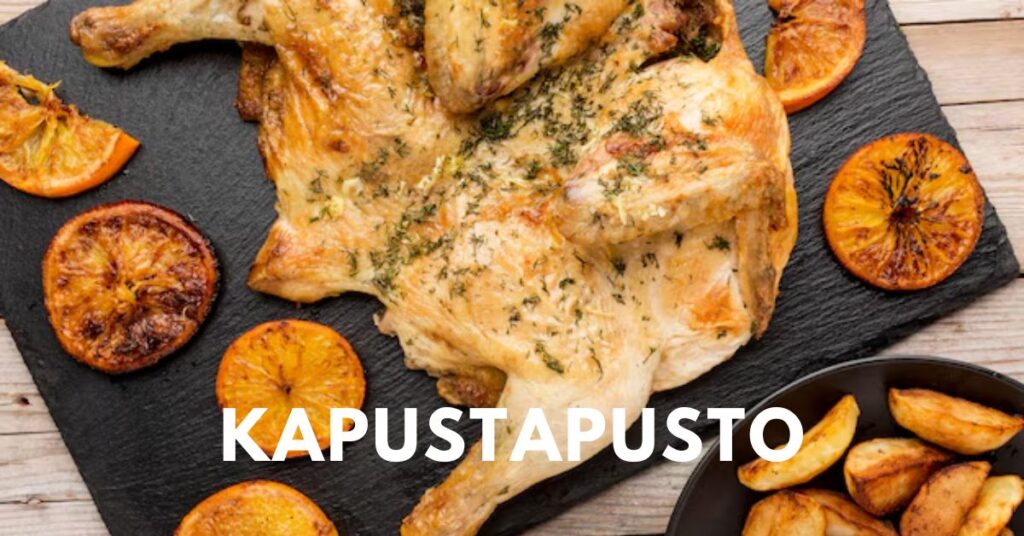Kapustapusto is more than just a dish; it’s a warm embrace wrapped in tradition and comfort. This hearty meal has been cherished across generations, bringing families together around the table. With its rich history and unique flavors, kapustapusto invites you to explore its origins, ingredients, and variations that span different cultures. Whether you’re familiar with this delight or hearing about it for the first time, get ready to embark on a culinary journey that celebrates both nostalgia and innovation. Let’s dive into the essence of kapustapusto!
What is Kapustapusto?
Kapustapusto is a delightful dish that embodies comfort and warmth. Often described as a hearty stew or casserole, it features layers of flavors that intertwine beautifully.
At its core, kapustapusto typically includes ingredients like cabbage, potatoes, and various meats or legumes. Its rich texture makes each bite satisfying.
This dish stands out for its versatility. You can find variations with different spices and vegetables based on regional preferences. It evokes feelings of home-cooked meals shared among loved ones.
Traditionally served during gatherings or festive occasions, kapustapusto transcends mere sustenance; it symbolizes togetherness and community spirit. While the preparation may vary from family to family, the heart of this meal remains constant—nourishing both body and soul in every bowl.
The Origins and History of Kapustapusto
Kapustapusto traces its roots back to Eastern European traditions, where it was a staple during harsh winters. Its name derives from “kapusta,” meaning cabbage in several Slavic languages, highlighting the core ingredient that defines this beloved dish.
Historically, families would gather to prepare Kapustapusto as a communal effort. It symbolized warmth and togetherness amidst cold weather. Passed down through generations, recipes evolved but retained their comforting essence.
In rural communities, each family added its own flair—some incorporating meats while others focused on vegetarian versions. The dish not only nourished bodies but also strengthened bonds among loved ones.
As migration spread cultures across continents, so did Kapustapusto. Today, it can be found in various forms worldwide yet remains deeply rooted in tradition and nostalgia for those who grew up enjoying it at home.
Traditional Ingredients and Preparation Methods
Kapustapusto embodies a rich tapestry of flavors, deeply rooted in tradition. At its core, this dish features cabbage as the star ingredient. Fresh, crisp leaves are often fermented or sautéed to bring out their natural sweetness.
Accompanying the cabbage is a medley of hearty vegetables like carrots and potatoes. These add both texture and nutrition, making each bite satisfying.
Spices play an essential role too. Common seasonings include dill, garlic, and peppercorns, which enhance the dish’s savory profile. The balance of these elements creates a comforting experience that warms the soul.
Preparation methods vary by region but generally involve slow cooking to develop layers of flavor. Some families still rely on age-old techniques passed down through generations—cooking in cast-iron pots adds depth to every serving.
The love for Kapustapusto shines through in both preparation and enjoyment at family gatherings across cultures.
Variations of Kapustapusto Across Different Cultures
Kapustapusto transcends borders, taking on unique forms in various cultures. In Eastern European countries, it often features cabbage and hearty meats, reflecting local agricultural practices.
In Germany, you might encounter a version that incorporates potatoes and spices. This variant highlights the region’s love for earthy flavors and comforting textures.
Meanwhile, South American adaptations introduce beans and corn. These ingredients add vibrant colors and nutritional density to the dish, showcasing how kapustapusto can evolve while staying true to its roots.
Asian interpretations may include tofu or bok choy. The fusion of these elements creates a lighter yet equally satisfying experience.
Each culture adds its personal touch to this beloved dish, making kapustapusto a delightful representation of culinary diversity around the world.
Modern Twists on the Classic Dish
Chefs today are reimagining kapustapusto, bringing a fresh perspective to this beloved comfort food. One popular twist incorporates quinoa for added protein and texture. This not only enhances the dish but also caters to health-conscious eaters.
Another creative adaptation involves using vibrant seasonal vegetables like kale or roasted bell peppers, adding color and nutrition. These ingredients offer delightful flavor contrasts while maintaining the traditional essence of kapustapusto.
For those with adventurous palates, some culinary artists experiment by infusing bold spices such as smoked paprika or cumin, providing an unexpected depth. Vegan variations are on the rise too; plant-based creams replace sour cream without sacrificing richness.
Then there’s the fusion approach—think kapustapusto tacos! Wrapping filling in soft tortillas introduces a playful element that can appeal to younger audiences. Each modern take breathes new life into a classic dish while honoring its roots.
Health Benefits of Kapustapusto
Kapustapusto is not just a comfort food; it also packs a nutritional punch. Rich in vitamins and minerals, this dish often features ingredients like cabbage, which is high in vitamin K and C. These nutrients support immune function and promote healthy skin.
The fermentation process commonly used for its preparation can enhance gut health. Probiotics from fermented foods aid digestion, keeping your microbiome balanced.
Additionally, the hearty nature of Kapustapusto provides lasting energy. It’s perfect for those needing stamina throughout their day without heavy meals weighing them down.
Including Kapustapusto in your diet may also help reduce inflammation due to its antioxidant-rich components. This makes it an excellent option for anyone looking to maintain overall wellness while enjoying delicious flavors.
Combining tradition with health benefits makes Kapustapusto more than just a meal; it’s part of a holistic lifestyle choice.
How to Incorporate Kapustapusto into Your Diet and Lifestyle
Incorporating kapustapusto into your diet is both simple and rewarding. Start by adding it as a hearty side dish to your meals. Its savory flavor complements meats, fish, and vegetarian plates alike.
Experiment with breakfast options too. A scoop of kapustapusto can elevate your morning omelet or serve as a filling for breakfast burritos. The versatility here is remarkable.
For lunch, consider integrating it into salads or grain bowls. It adds texture and depth while providing essential nutrients that keep you energized throughout the day.
If you’re feeling adventurous, try making wraps using whole-grain tortillas filled with kapustapusto and fresh vegetables. It’s an easy way to pack in flavor without sacrificing health.
Snacking on small portions during the day can also be beneficial. Pair it with whole grain crackers or fresh veggies for a satisfying bite between meals.
Conclusion: Keeping Tradition Alive with Kapustapusto
Kapustapusto has a way of bringing people together. This dish, steeped in tradition and history, transcends generations. It evokes feelings of warmth, comfort, and nostalgia. In today’s fast-paced world, savoring Kapustapusto is like taking a step back to simpler times.
As more people discover the rich flavors and health benefits of this meal, there’s hope that it will remain part of our culinary landscape for years to come. By embracing both its traditional roots and modern variations, we can keep the spirit of Kapustapusto alive.
Incorporating this delightful dish into your cooking routine not only enriches your diet but also honors the cultural stories behind it. Whether you enjoy it with family or share it with friends at gatherings, Kapustapusto serves as a delicious reminder of our shared heritage.
Let each bite serve as an invitation to explore new recipes while respecting ancient practices. Celebrate Kapustapustos in all its forms—traditional or contemporary—and let it continue to be a source of joy and comfort for everyone who experiences its unique essence.
FAQs
1. What is Kapustapusto?
Kapustapusto is a comforting and hearty dish, often enjoyed as a stew or casserole. It typically features cabbage, potatoes, and various meats or legumes, with a rich, satisfying texture. The dish is cherished for its versatility and tradition, symbolizing togetherness and home-cooked warmth.
2. How did Kapustapusto originate?
Kapustapusto originated in Eastern Europe, where it was a staple during cold winters. Its name comes from “kapusta,” the Slavic word for cabbage, highlighting its main ingredient. The dish was traditionally prepared as a communal effort, evolving over generations while retaining its comforting essence.
3. What are some common ingredients in Kapustapusto?
Common ingredients include cabbage, potatoes, carrots, and a variety of meats or legumes. Spices such as dill, garlic, and peppercorns are used to enhance the flavor. The dish often involves slow cooking to develop deep, layered flavors.
4. How do different cultures put their spin on Kapustapusto?
Kapustapusto varies by culture: Eastern European versions might feature meats and cabbage, while German versions incorporate potatoes and spices. South American adaptations include beans and corn, and Asian versions may use tofu or bok choy. Each culture adds its unique touch, reflecting local tastes and ingredients.
5. Can Kapustapusto be adapted for modern dietary needs?
Yes, Kapustapusto can be adapted for modern diets. For example, quinoa can replace traditional grains for added protein, and vibrant seasonal vegetables like kale can be used. Vegan versions substitute plant-based creams for dairy, and inventive twists like Kapustapustos tacos offer playful, contemporary options.







